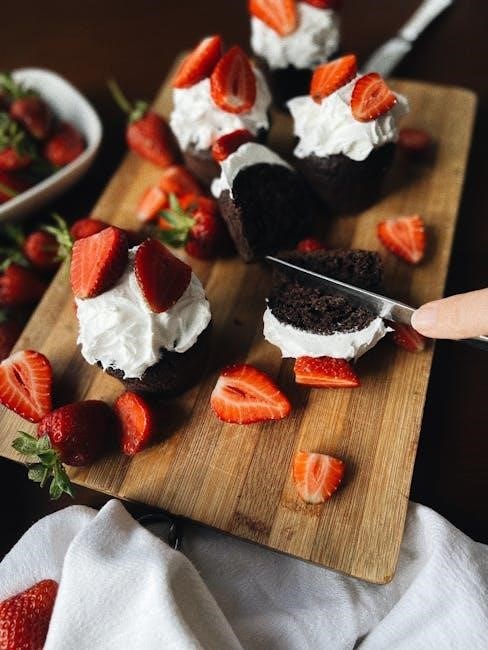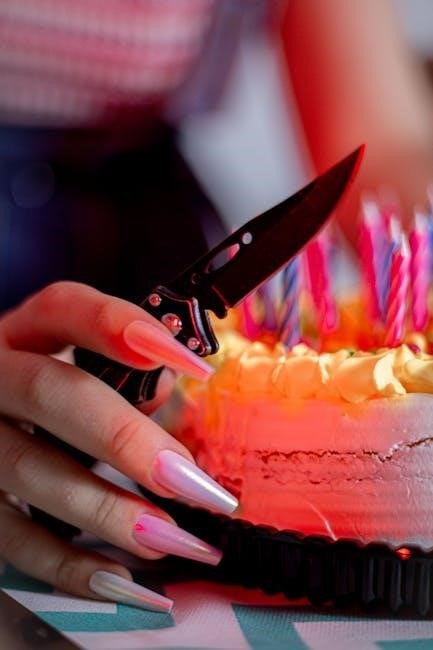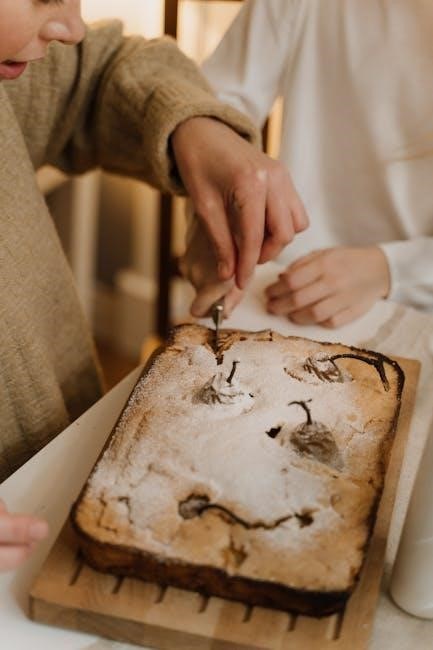The Wilton Cake Cutting Guide is your ultimate resource for mastering cake serving techniques, ensuring even slices and efficient serving at any event. Whether you’re a beginner or an experienced baker, this guide provides expert tips for flawless cake presentation.
Overview of the Wilton Cake Cutting Method
The Wilton Cake Cutting Method is a systematic approach designed to ensure even, consistent slices and efficient serving. This method emphasizes precision and organization, making it ideal for both professional bakers and home enthusiasts. By using a combination of tools and techniques, the Wilton method helps achieve uniform portion sizes while maintaining the cake’s visual appeal. It begins with preparing the cake by leveling and crumb-coating, followed by marking slices using a serrated knife or cake cutter. The process ensures minimal waste and streamlined serving, especially for large events like weddings or parties. The method also includes tips for cutting tiered cakes, making it a versatile solution for any celebration. With the Wilton guide, anyone can master the art of cake cutting, delivering perfect slices every time.

Understanding Standard Cake Serving Sizes
Standard cake serving sizes typically range from 1×2 inches for round cakes to larger portions for tiered designs. Wilton provides charts to help determine slices per cake size and shape.

How to Determine the Number of Slices per Tier
To determine the number of slices per tier, start by measuring the diameter and height of each cake layer. Use Wilton’s recommended serving chart as a reference. For round cakes, the number of slices is based on the cake’s diameter. A standard 6-inch tier typically yields 8-10 slices, while an 8-inch tier provides 12-15 slices. Larger tiers, such as 10-inch or 12-inch, can serve 20-25 slices or more, depending on serving size. For tiered cakes, calculate each tier separately and add the total number of slices for the entire cake. Consider the serving size and frosting thickness, as these factors can affect the number of slices. Always use a serrated knife and level the cake before cutting to ensure even portions. Wilton’s guide also offers visual aids and step-by-step instructions to help you achieve consistent results.
Wilton’s Recommended Serving Chart for Round and Tiered Cakes
Wilton’s serving chart provides a clear guide for determining the number of servings for round and tiered cakes. For round cakes, a 6-inch tier typically serves 8-10 guests, while an 8-inch tier serves 12-15 guests. A 10-inch tier can serve 20-25 guests, and a 12-inch tier serves 25-30 guests. For tiered cakes, Wilton recommends calculating each tier individually and summing the total servings. For example, a three-tiered cake with 6-inch, 8-inch, and 10-inch tiers can serve 35-45 guests. The chart also accounts for frosting thickness and serving size, ensuring accurate portioning. Wilton’s chart is a valuable resource for event planners and bakers, helping to ensure every guest receives a consistent and generous slice. Use this chart alongside Wilton’s cutting techniques for seamless cake serving at any event. Visit Wilton’s website for detailed charts and visual guides to maximize your cake’s potential.

Basic Cake Cutting Techniques
Mastering basic cake cutting techniques ensures even slices and a clean presentation. Start by leveling the cake, then use a serrated knife to make smooth, consistent cuts. Perfect for round and tiered cakes.
Tools You Need for Cutting a Wilton Cake

To cut a Wilton cake effectively, you’ll need the right tools. Start with a serrated knife, which is ideal for slicing through cake layers smoothly. A cake turntable is also essential, allowing you to spin the cake for even cutting. For serving, use a cake server or an offset spatula to lift and transfer slices neatly. Additionally, a clean, hot knife (dipped in warm water and dried) ensures precise cuts without tearing the cake. If your cake is tiered, consider using cake dowels or supports to stabilize the layers before cutting. Lastly, have a large serving plate or cake stand ready to display the slices attractively. These tools will help you achieve professional-looking results and make the cutting process efficient and stress-free.
Step-by-Step Guide to Cutting Even Cake Slices
To achieve even cake slices, start by placing the cake on a cake turntable for easy access. Use a serrated knife to make a small indentation around the edge of the cake, marking where you’ll cut. Determine the number of slices based on the cake’s size and your needs. Hold the knife horizontally and make a steady, even cut from the top edge down to the bottom, using the indentations as a guide. After each cut, remove the slice with a cake server or offset spatula and place it on a serving plate. Wipe the knife clean with a damp cloth after each slice to prevent crumbs and frosting from building up. Repeat this process, rotating the cake as needed, until all slices are cut. This method ensures uniform portions and a clean, professional presentation for your event.
Advanced Tips for Cutting Large Cakes
For large cakes, ensure stability by using dowels or cake boards between tiers. Underbake slightly for easier stacking and smoother frosting. Use a sharp knife and steady motion for clean cuts, ensuring even distribution of layers and frosting for a professional finish.
How to Cut a Multi-Tiered Cake Efficiently
Cutting a multi-tiered cake requires precision and care to ensure even slices and a polished presentation. Begin by removing the dowels or supports between tiers to separate them. Place the cake on a sturdy turntable for easy access to all sides. Start with the bottom tier, using a long serrated knife to make smooth, even cuts. Cut slices slightly smaller than those from the upper tiers to maintain balance. For upper tiers, use a smaller knife and work from the outside in, ensuring each slice aligns with the ones below. Use a cake level or straight edge to guide your cuts for consistency. Finally, use a serving spatula to carefully lift and serve each slice without damaging the frosting or layers. This method ensures efficiency and professionalism, making your multi-tiered cake a stunning centerpiece at any event.
Maintaining Even Layers and Frosting When Cutting
Maintaining even layers and frosting when cutting a cake is essential for both presentation and taste. Begin by ensuring the cake is completely chilled, as this firms the frosting and prevents smudging. Use a sharp, serrated knife to make clean, precise cuts, applying gentle pressure to avoid compressing the layers. For even slices, cut in a smooth, sawing motion from top to bottom, rather than pressing down. To preserve frosting integrity, wipe the knife clean between cuts using a damp cloth or paper towel. For multi-layer cakes, use a cake level or straight edge to ensure uniformity. When serving, use a sturdy serving spatula to lift slices without breaking the layers. By following these steps, you can maintain the structural integrity and visual appeal of your cake, ensuring a professional finish every time. This approach guarantees even, beautiful slices that impress both visually and flavorfully.
Mastering the Wilton Cake Cutting Guide ensures confidence in serving perfectly even slices, enhancing both presentation and flavor for memorable events. Precision and care make every celebration sweeter.
Best Practices for Serving Cake at Events
When serving cake at events, planning and precision are key to ensuring a seamless experience. Always use a serrated knife for clean, even cuts, and pre-cut slices if possible to save time. For tiered cakes, work from the bottom tier upward to maintain stability. Use a cake stand or elevated platform to showcase the cake beautifully. Consider the venue’s lighting to highlight the cake’s design. Allow guests to request slice sizes, offering smaller portions for those with dietary restrictions. Keep extra serving utensils and plates on hand to avoid delays. Finally, designate a person to handle cake serving to ensure efficiency and maintain the cake’s presentation throughout the event.
